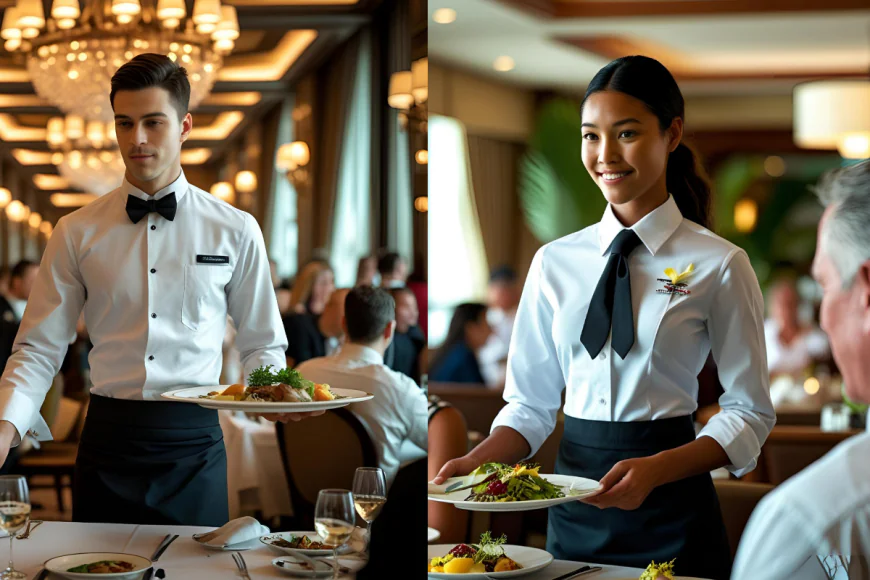Proper Uniform of a Waiter in Restaurant or Hotel
Discover the proper uniform for waiters in restaurants and hotels. Learn why a neat, professional look matters and how to dress for success in hospitality.

When you walk into a restaurant or hotel, one of the first things you notice about the staff is their uniform. For waiters, the uniform is more than just clothing—it’s a symbol of the restaurant’s style and a sign of professionalism. A proper uniform shows guests that the establishment cares about presentation and sets the tone for great service.
Let’s take a closer look at what makes a proper uniform for a waiter and why it’s important.
Why a Uniform Matters
The uniform of a waiter does more than just cover the body. It:
-
Represents the restaurant’s brand
-
Builds guest confidence
-
Creates a sense of team spirit
-
Boosts professionalism and hygiene
A well-dressed waiter can make guests feel comfortable and enhance the dining experience.
Basic Elements of a Waiter’s Uniform
Every restaurant or hotel might have slight differences in style, but the basics are usually the same:
1. Shirt or Blouse
-
Should be clean and neatly pressed
-
White is classic and formal, while black or dark shades are also common in modern venues
-
Short sleeves for a casual place or long sleeves for more formal settings
2. Trousers or Skirt
-
Dark trousers for a sharp, professional look
-
For female servers, some places offer skirts, but they must be comfortable and allow easy movement
3. Apron
-
Protects the uniform and provides a place for carrying order pads, pens, or a corkscrew
-
Aprons come in different lengths—waist aprons for casual service, or full aprons for more formal dining
4. Tie or Bow Tie (optional)
-
In more formal or upscale venues, a tie or bow tie adds a touch of elegance
-
Should be neat and match the overall uniform style
5. Waistcoat or Vest (optional)
-
Common in fine dining, a waistcoat or vest gives a refined appearance
-
Typically in dark colors like black or navy
6. Shoes
-
Closed-toe, non-slip shoes are essential for safety
-
Should be black or dark and polished for a neat look
Grooming and Personal Hygiene
The uniform isn’t just about the clothes—it’s about the whole appearance. Here’s what else matters:
-
Hair should be clean and neatly styled.
-
Fingernails should be short and clean.
-
Minimal or no jewelry (except a wedding band or simple earrings).
-
Light or no perfume/cologne to respect guests with allergies.
Seasonal Considerations
Depending on the climate and restaurant environment, uniforms may adjust slightly:
-
Summer: Lighter fabrics to keep cool.
-
Winter: Adding a blazer or jacket for warmth.
The key is to stay comfortable while maintaining a professional look.
Uniform Etiquette
Even the neatest uniform won’t look good if it’s not worn properly. Here are some tips:
-
Tuck in your shirt—it looks tidy and polished.
-
Check your apron to ensure it’s straight and tied well.
-
Look in the mirror before starting your shift.
-
Replace or repair damaged clothing—guests will notice!
Color and Branding
Many restaurants and hotels use specific colors or branded logos to match their theme. A uniform that matches the restaurant’s style:
-
Reinforces the brand image.
-
Helps guests identify staff easily.
-
Creates a cohesive, welcoming environment.
Cultural and Theme Variations
In some restaurants—like Italian trattorias or Japanese sushi bars—uniforms reflect the cuisine or theme. This adds authenticity and enhances the overall dining experience.
For example:
-
Japanese restaurants might feature a simple kimono-style top.
-
French bistros might have classic white shirts and black vests.
Conclusion
A proper uniform for a waiter is a balance of comfort, safety, and style. It’s about looking neat, feeling confident, and creating a welcoming atmosphere for guests. From a crisp shirt to well-polished shoes, every detail counts in making the dining experience special.
By dressing smartly and paying attention to small details, waiters show that they care about their work and their guests. It’s a small step that makes a big difference in the world of hospitality.



 Saurav Sarkar
Saurav Sarkar 




